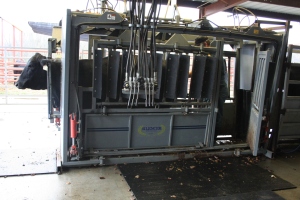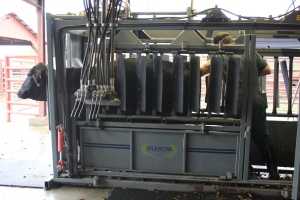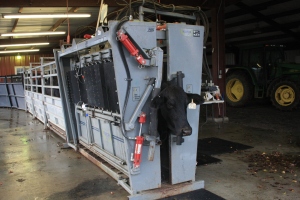In one of my prior post I wrote about The Herdsman getting some of the cow’s ready for Embryo transfers. Last friday the Vet came to the farm to put the Embryo’s in to the recipt cow’s. It’s a tedious process that is time-consuming and specialized.
The use of a chute when working cattle is imperative, as the cattle in most cases do not need to move around very much. This device doesn’t hurt the cattle and is only temporary confinment. The back of the chute has a door that allows a person to enter the chute. When placing embryo’s into the recipient cow the veterinarian will deposit the collected specimen into the cow’s uterus. The placement of the specimen can take several minutes.

The process of embryo transfer is beneficial to the purebred industry for the simple fact that it gives the ability to the producer to gain superior offspring into their herd. The purebred producer is in the business of producing cattle that enhance the consumers wants. This is done by selective breeding of the cattle. The cattle are evaluated by ultrasounding the ribeye area for size and the inter muscular fat ( IMF). The ribeye is measured between the 12th and 13th rib and is part of the longissimus muscle. The measurement is taken in square inches and gives a good indication of the total muscle mass of the cattle. This is important in determining what the carcass will grade out to be before slaughter. Before beef carcass imaging, a producer would have to wait until after their cattle were sent to slaughter to find out the quality of the cattle they produced. By the time cattle go to slaughter most producers already have one if not two years worth into them. By gaining the knowledge before slaughter, the producers are able to make better bull and cow breding selections. If you are interested in how this information is valuable to the producer, I suggest reading http://www.caes.uga.edu/publications/pubDetail.cfm?pk_id=7742#Measurements.
The cattle owner is making his/her breeding selections based what the outcome of the cross will deliver. The producer is working toward a superior herd that will produce high yield products. Not all cows can produce this outcome in a calf, so they are selected to carry an embryo that has that potential. This benefits both the cow and the breeder, as the cow gets to be a mother and the breeder gets their desired calf.


